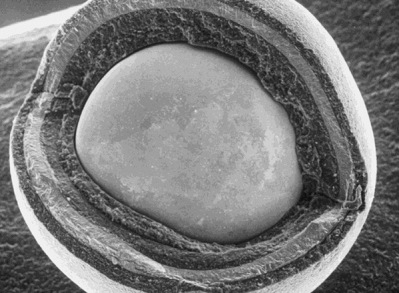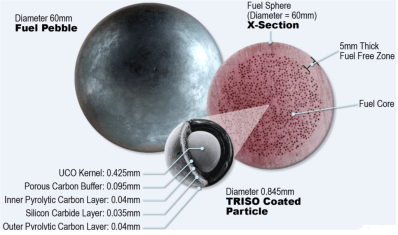A nuclear power plant is large and complex, and one of the biggest reasons is safety. Splitting radioactive atoms is inherently dangerous, but the energy unleashed by the chain reaction that ensues is the entire point. It’s a delicate balance to stay in the sweet spot, and it requires constant attention to the core temperature, or else the reactor could go into meltdown.
Today, nuclear fission is largely produced with fuel rods, which are skinny zirconium tubes packed with uranium pellets. The fission rate is kept in check with control rods, which are made of various elements like boron and cadmium that can absorb a lot of excess neutrons. Control rods calm the furious fission boil down to a sensible simmer, and can be recycled until they either wear out mechanically or become saturated with neutrons.
Nuclear power plants tend to have large footprints because of all the safety measures that are designed to prevent meltdowns. If there was a fuel that could withstand enough heat to make meltdowns physically impossible, then there would be no need for reactors to be buffered by millions of dollars in containment equipment. Stripped of these redundant, space-hogging safety measures, the nuclear process could be shrunk down quite a bit.

What if meltdowns weren’t a thing?
The answer seems simple enough, doesn’t it? If we could make a fuel that can naturally withstand more heat than it needs to, then, we could do away with control rods, huge water baths, and concrete cooling towers.
Such a fuel already exists, and its time seems to have come. Triso — short for tristructural isotropic — takes the form of pellets the size of poppy seeds that are made of enriched uranium and oxygen. It was first developed in the UK for the experimental Dragon reactor.
Each triso pellet is coated with a multi-layer candy shell made of graphite and silicon carbide that serves the same purpose as the control rod: safely containing fission. Thanks to this multi-layer shell, triso can withstand extremely high heat — way more heat than it would ever face inside of a standard reactor. Triso has been tested to withstand 3200 °F / 1760 °C, which is three times hotter than a typical reactor runs today. The US Department of Energy describes triso as the most robust nuclear fuel on Earth.
Triso is made by treating uranium ore with chemicals that break it down into tiny beads. The beads are put into a furnace and blasted with gases that break down in the heat and coat the beads with protective deposits.
Nuclear Nuggets and Power Balls
So why haven’t we been using triso instead of fuel rods all these years? There are a few reasons. In its natural state, triso isn’t energy-dense enough for today’s large light-water reactors.

Triso is also expensive to make, so there hasn’t been a great deal of research until the last twenty years or so when the Department of Energy started funding companies who were building smaller, high-temperature reactors.
There are two companies in the US that are currently producing both triso and triso-compatible nuclear reactors. BWXT is making triso fuel cylinders that look a lot like bite-sized fuel rods.
A company called X-Energy is manufacturing a secret blend that they refer to as ‘power balls’. It’s tens of thousands of triso particles packed into a sphere the size of a billiard ball, and it’s designed to work with the company’s pebble bed reactor that produces 1/8th the power of a standard reactor. Each power ball is good for six trips through their Xe-100 pebble bed reactor before it wears out, which makes the lifespan about three years.
The Department of Energy aren’t the only ones betting on triso as the future of nuclear fuel. The Department of Defense is pitting BWXT and X-Energy against each other to develop a mobile reactor for military use, and NASA is revisiting the idea of nuclear-powered rockets.
No comments:
Post a Comment